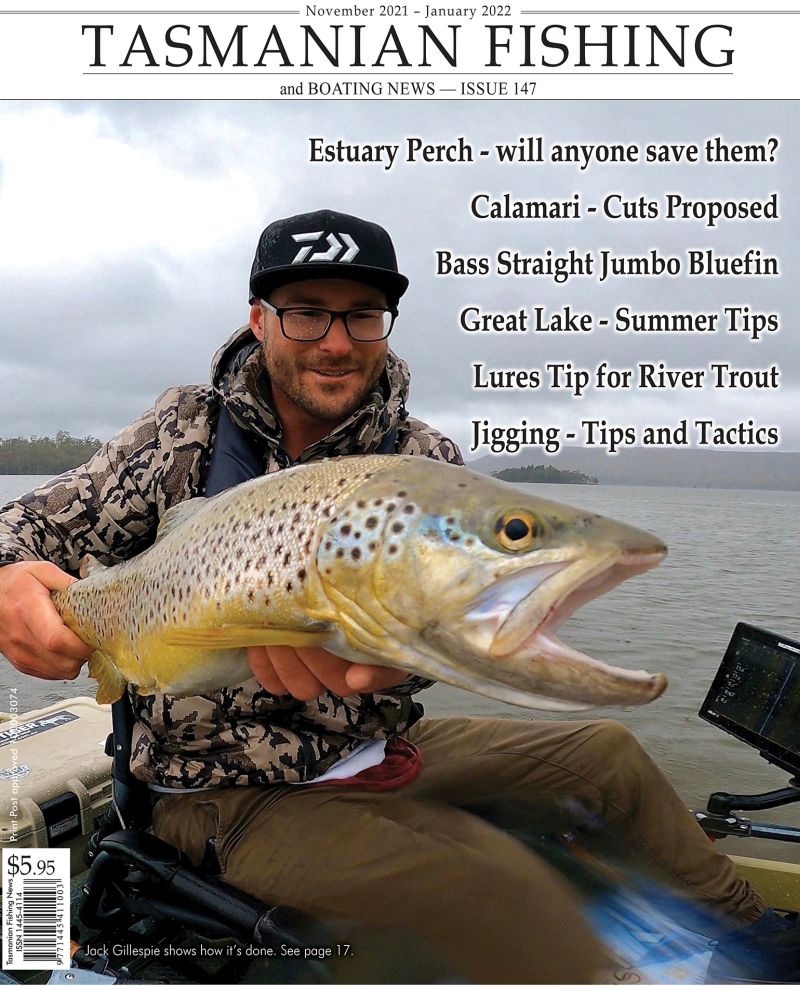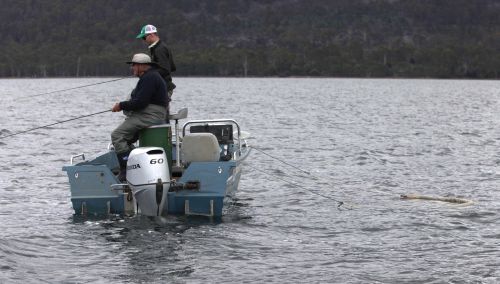Nymph under Dry - double your chances
Joe RileyThose who fish the rivers around Tasmania all enjoy the sight of a black spinner drifting along a riffle disappearing in the slight swirl created by a good sized brown sucking the fly through the surface film of the water.
As October and November approach the prospects of this type of fishing improve by the day. Fine, calm warm days bring on the hatches of mayfly and other insects as waters warm in keeping with the weather. Early on in spring however these sessions are usually short and sporadic and the wise river fisherman needs to have plenty of strings to his bow if he wants to achieve success between hatches and falls. One of these "strings" is the Nymph under Dry.
Nymph under Dry is at first glance an extremely simple concept, tie a nymph to your dry fly and drift the dry and nymph together and watch the dry fly for a take. Nymph under Dry can be fished in this simple manner, however like any form of fishing the more attention you pay to detail the more reward you are likely to reap. When fished intelligently this technique is deadly, and will account for plenty of fish in the quiet times trout are not rising freely to a dry fly alone.
Here is the set up and how best to fish it, the important thing to remember is contact. As with so many types of sub surface fly fishing, the important thing is to have contact with the fly, a take and rejection of the fly can happen swiftly and they need to register straight away if contact is to be made with the fish who has inhaled the fly under water.
In nymph under dry the contact needs to be between the nymph and the dry fly which you are basically using as a strike indicator. In this package you also need to take into account the depth of water you are fishing and the size and weight of the flies you are using as these will effect how deep your nymph gets. I keep a jig of pre tied dry fly and and tungsten bead head nymphs on a foam pad on my vest, all of the dry flies and nymphs get bigger as the droppers get longer, this way I can change quickly from a shallow set up with small flies to a larger set up for a deeper run, just like changing a single fly.
Trout in Tasmanian rivers are rarely selective in the form of underwater food they receive. I say receive purposely because, by their very nature, trout sit in sheltered lies where the effect of the current on them is minimised. This way they don't expend much energy while a hatch is not in full swing and food is not in abundance. While in these lies potential food items drift past them on the current and the trout need to decide whether this food is acceptable or not. It is often an instant decision, so they rarely scrutinize heavily and will usually take a range of nymphs in various sizes, including size 8 bead head nymphs. You can fish these large nymphs confidently in deeper water, knowing they will drift along close to the bottom, suspended by a similarly large dry fly.
If you have any doubt about large nymphs being taken by trout, take a look at some of the rocks on rivers around the State, you will soon see the size of some of the sub-aqueous food items available to the trout. Little rivers like the Liffey and Lake rivers in the north and Tyenna in the south have large stonefly with a nymph that crawls out and hatches on the rocks in the river. These nymphs are regularly a size 6 hook length, and are a great meal for a small fish sitting in wait should they dislodge into the current at any stage.
The flies:
Bushy, buoyant dry flies are the most suitable choice for the top of the set up, a bushy dry fly will hold up a weighted nymph in a similar size range to itself. Flies like the Humpy or Royal Wulff are ideal, particularly in faster slightly turbulent water. On smoother water a parachute fly tied with a bright post material is also a good option, provided the choice of nymph does not pull the fly under too easily.
There are many choices for nymphs, however tungsten bead head patterns are my favoured option when fish are in holding positions near the river bed. The weight of tungsten compared to it's relative size is excellent. A tungsten bead head nymph sinks quickly and will get down to a required depth moments after hitting the water, meaning it will fish effectively for longer on your chosen drift.
As a general guide for nymphs, apply the following nymph /bead sizes, and match the dry fly in a corresponding size to the nymph.
Hook size Bead
8 3.8mm
10 3.3mm
12 2.8mm
14 2.3mm
16 2.0mm
When attaching the nymph to the dry, tie the leader to the nymph in the New Zealand "truck and trailer" style. Tie the section of leader to attach the nymph onto the bend of the dry fly hook. Measure out the appropriate length of leader and then tie the nymph to the tippet. Droppers are not used because they are not in direct contact and a nymph can be taken as soon as it hits the water. Again as a guide try the following;
Hook size Distance to nymph
8 1.2m
10 900mm
12 600mm
14 450 - 600mm
16 450 - 600mm
The deeper the run the longer the distance between the nymph and the dry. This technique is good to water about 1m deep, but because the likelihood of losing contact with the nymph increases as the tippet lengthens, the effectiveness of this method decreases correspondingly.
Method
Remembering contact is the important key in sub surface techniques, the best way to fish Nymph under Dry is upstream with a straight leader between the dry and the nymph.
Working upstream, cast a straight line so it can drift naturally down a current seam or riffle. Casts do not need to be long, particularly when you are fishing rippled water, trout in this type of water are easy to approach and will not spook until you are right on them provided you move carefully and slowly. Fish a short line casting about 30ft in front of you, let the flies drift back taking in slack, keep the rod high from the start and raise it further as the flies get close to you. Fishing with a "high stick" you have a more direct line to the dry fly and a strike can be made easily, quickly and more effectively.
Watch the dry fly intently and any pause or pull of the fly under the surface should be met with a quick strike. Also don't be surprised when the dry fly gets eaten and remember the strike to this take will need to be a more measured response in keeping with normal dry fly fishing.
Now work the river carefully, probing every likely lie with a cast. If you find a spot where you just "know" a fish is likely to be cover it with multiple casts as inches can be feet and you will often not quite get the cast right to induce a take first time.
Pay attention to deeper runs along the bank, pockets created by under water rocks and the seams that flow out behind them. Fish in front of submerged rocks also as fish can sit in the shelter created in front of the rock as the flow divides around and over it. Riffles are always good holding spots as there are multiple holding lies for fish in a given area, work these areas methodically.
A couple of alternatives
Long, smooth, slow moving pools provide an opportunity to drift smaller nymphs on a longer leader under a dry. Here you lengthen your cast, and make long drifts in the manner previously described. As the water is not turbulent the nymphs should settle into a drift with good contact to the dry fly and takes will be easily seen.
When fish are smutting or taking tiny emergers, you can fish a very small fly behind a sighter dry fly in the Nymph under Dry style this way you will know how close your tiny #18 or #20 emerger is and can get a visible clue to a take by a pull on the dry fly.
Finally, Nymph under Dry is a very effective method of fly fishing rivers. It does have limitations as do all techniques. Heavy turbulent water and deep water over one metre are both limitations to the effectiveness of the method but as I said at the beginning this is only one string to the river fisherman's bow, and there are other techniques to deal with these situations.
Give Nymph under Dry a run between those dun hatches and spinner falls this spring. It is a technique that will catch trout, not just now but thoughout the whole season whenever our beautiful Tasmanian rivers are at settled levels suitable for fly fishing.
Joe Riley



